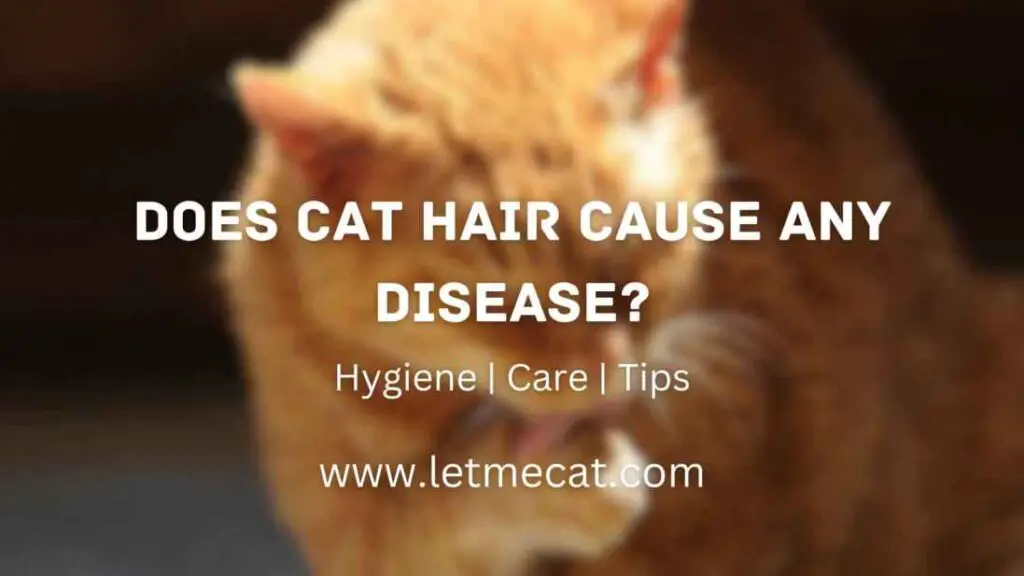In this article, we will explore the relationship between cat hair and potential health problems. While cat hair itself may not directly cause diseases, it can contribute to certain health conditions, particularly in individuals with specific sensitivities or compromised immune systems.
What is Cat Hair?
Cat hair is composed of a protein called keratin, which is also present in human hair. It serves as a protective layer for cats’ skin, regulating body temperature and providing insulation.
Cats shed their hair regularly as part of their natural growth cycle, which helps them maintain healthy skin and fur.
Common Health Issues Associated with Cat Hair
While cat hair is generally harmless, it can be problematic for individuals with certain sensitivities or health conditions. The most common health issues associated with cat hair include allergies, asthma, and cat scratch disease.
Is Cat Hair the Direct Cause of Diseases?
It’s important to note that cat hair itself is not the direct cause of diseases. Instead, it acts as a carrier for allergens, bacteria, and other particles that may trigger health problems in susceptible individuals. Understanding the specific conditions associated with cat hair can help us mitigate potential risks.
Cat Hair and Allergies
Understanding Allergens: Allergens are substances that can cause an allergic reaction in certain individuals. In the case of cat hair, the primary allergen is a protein called Fel d 1, which is found in a cat’s saliva, urine, and skin glands. When cats groom themselves, the allergen can become attached to their hair, and once shed, it can linger in the environment.
Symptoms of Cat Allergies: People who are allergic to cat hair may experience symptoms such as sneezing, nasal congestion, itching, watery eyes, and skin rashes. These symptoms occur when the body’s immune system overreacts to the presence of the allergen.
Asthma and Cat Hair
Triggers for Asthma Attacks: For individuals with asthma, cat hair can act as a trigger for respiratory symptoms. Asthma is a chronic condition characterized by inflammation and narrowing of the airways, leading to wheezing, coughing, and difficulty breathing. Exposure to cat hair can potentially worsen these symptoms or even trigger an asthma attack.
Managing Asthma with Cats: If you have asthma and live with cats, there are steps you can take to minimize the risk. Keeping cats out of bedrooms, using air purifiers with HEPA filters, and regularly cleaning the living environment can help reduce the presence of cat allergens and minimize asthma triggers.
Cat Scratch Disease and Cat Hair
Transmission of Cat Scratch Disease: Cat scratch disease, also known as cat scratch fever, is caused by a bacterium called Bartonella henselae. This disease can be transmitted to humans through cat scratches or bites. While cat hair itself is not responsible for transmitting the disease, cats may have bacteria on their claws or paws, which can transfer to humans during play or interaction.
Preventing Cat Scratch Disease: To reduce the risk of cat scratch disease, it’s essential to practice proper hygiene and avoid rough play with cats. Regularly trimming their claws, discouraging scratching behavior, and washing hands thoroughly after handling cats can help prevent infection.
Importance of Proper Hygiene and Maintenance
To minimize potential health risks associated with cat hair, maintaining proper hygiene and regular grooming is crucial. Some important practices include:
Regular Grooming: Regularly brushing your cat’s fur can help reduce shedding and the spread of allergens. This practice also promotes a healthy coat and prevents matting.
Cleaning the Living Environment: Vacuuming, dusting, and wiping surfaces regularly can help remove cat hair and minimize the presence of allergens in the home. Using a vacuum cleaner with a HEPA filter is especially effective in capturing fine particles.
Tips for Living with Cats and Minimizing Health Risks
Living with cats can be enjoyable, even for individuals with sensitivities or health conditions. Here are some tips to help minimize health risks while enjoying the company of feline companions:
Keeping Cats Out of Bedrooms: Designating cat-free zones, such as bedrooms, can provide a space where individuals can retreat to minimize exposure to cat allergens.
Using Air Purifiers: Investing in air purifiers with HEPA filters can help capture airborne allergens, including cat hair and dander, improving indoor air quality.
Conclusion
Cat hair itself does not cause diseases, but it can contribute to health issues in susceptible individuals. Allergies, asthma, and cat scratch disease are common concerns associated with cat hair.
By understanding these conditions and implementing proper hygiene practices, individuals can live comfortably with cats while minimizing potential health risks.
Thank you for reading this article.



